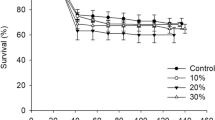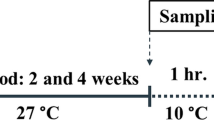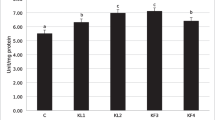Abstract
Insects are attracting increasing worldwide attention as living organisms that produce various useful substances. Although a wide variety of bioactive substances have been identified in insects, there has been little study of the dietary effects of insects that contain these useful substances. In our present study, we describe the dietary effects of housefly [Musca domestica (Linnaeus)] pupae in the red sea bream [Pagrus major (Temminck and Schlegel)]. The addition of low levels of housefly pupae to the diets of these fish caused significant increases in fork length and body weight and produced a marked improvement in feed conversion after 24 days of feeding. Furthermore, the results of 6-month feeding trials revealed that low dietary levels of housefly pupae promote growth performance in the red sea bream. We further found that dietary housefly pupae significantly enhance the peritoneal leukocyte phagocytic activity in the red sea bream and provides increased protection against a lethal challenge from a major pathogen in this species, Edwardsiella tarda (Ewing et al). We also show that housefly pupae dietary supplements do not negatively affect the health of rats [Rattus norvegicus (Berkenhout)]. Our current results indicate the great potential of insects as functional feed sources for farmed fish.







Similar content being viewed by others
References
Akiyama N, Hijikata M, Kobayashi A, Yamori T, Tsuruo T, Natori S (2000) Anti-tumor effect of N-beta-alanyl-5-S-glutathionyldihydroxyphenylalanine (5-S-GAD), a novel anti-bacterial substance from an insect. Anticancer Res 20:357–362
Baeverfjord G, Krogdahl Å (1996) Development and regression of soybean meal induced enteritis in Atlantic salmon, Salmo salar L., distal intestine: a comparison with the intestines of fasted fish. J Fish Dis 19:375–387
Baranyovitz FLC (1978) Cochineal carmine: an ancient dye with a modern role. Endeavour 2:85–92
Bricknell I, Dalmo RA (2005) The use of immunostimulants in fish larval aquaculture. Fish Shellfish Immunol 19:457–472
Chernysh S, Kim SI, Bekker G, Pleskach VA, Filatova NA, Anikin VB, Platonov VG, Bulet P (2002) Antiviral and antitumor peptides from insects. Proc Natl Acad Sci USA 99:12628–12632
El Boushy AR (1991) House-fly pupae as poultry manure converters for animal feed: a review. Bioresour Technol 38:45–49
Esteban MA, Mulero V, Cuesta A, Ortuño J, Meseguer J (2000) Effects of injecting chitin particles on the innate immune response of gilthead seabream (Sparus aurata L.). Fish Shellfish Immunol 10:543–554
Esteban MA, Cuesta A, Ortuño J, Meseguer J (2001) Immunomodulatory effects of dietary intake of chitin on gilthead seabream (Sparus aurata L.) innate immune system. Fish Shellfish Immunol 11:303–315
Feng X, Cheng G, Chen SY, Yang H, Huang W (2010) Evaluation of the burn healing properties of oil extraction from housefly larva in mice. J Ethnopharmacol 130:586–592
Ford ES (2005) Risks for all-cause mortality, cardiovascular disease, and diabetes associated with the metabolic syndrome: a summary of the evidence. Diabetes Care 28:1769–1778
Fox CS, Massaro JM, Hoffmann U, Pou KM, Maurovich-Horvat P, Liu CY, Vasan RS, Murabito JM, Meigs JB, Cupples LA, D’Agostino RB Sr, O’Donnell CJ (2007) Abdominal visceral and subcutaneous adipose tissue compartments: association with metabolic risk factors in the Framingham Heart Study. Circulation 116:39–48
Francis G, Makkar HPS, Becker K (2001) Antinutritional factors present in plant-derived alternate fish feed ingredients and their effects in fish. Aquaculture 199:197–227
Fu P, Wu J, Guo G (2009) Purification and molecular identification of an antifungal peptide from hemolymph of Musca domestica (housefly). Cell Mol Immunol 6:245–251
Fuke S, Konosu S, Ina K (1981) Identification of feeding stimulants for red sea bream in the extract of marine worm Perinereis brevicirris. Nippon Suisan Gakk 47:1631–1635
Furutani T, Masumoto T, Fukada H (2012) Response of cholecystokinin and digestive enzyme mRNA levels to various feed ingredients in yellowtail Seriola quinqueradiata. Fish Sci 78:1075–1082
Goh Y, Tamaru T (1980) Effect of amino acids on the feeding behavior in red sea bream. Comp Biochem Physiol 66C:225–229
Heek MV, Farley C, Compton DS, Hoos L, Davis HR (2009) Ezetimibe selectively inhibits intestinal cholesterol absorption in rodents in the presence and absence of exocrine pancreatic function. Br J Pharmacol 134:409–417
Hidaka I, Kohbara J, Araki T, Morishita T, Miyajima T, Shimizu S, Kuriyama I (2000) Identification of feeding stimulants from a jack mackerel muscle extract for young yellowtail Seriola quinqueradiata. Aquaculture 181:115–126
Hirose Y, Ohta E, Kawai Y, Ohta S (2013) Dorsamin-A’s, glycerolipids carrying a dehydrophenylalanine ester moiety from the seed-eating larvae of the bruchid beetle Bruchidius dorsalis. J Nat Prod 76:554–558
Hou L, Shi Y, Zhai P, Le G (2007) Antibacterial activity and in vitro anti-tumor activity of the extract of the larvae of the housefly (Musca domestica). J Ethnopharmacol 111:227–231
Huis AV, Itterbeeck JV, Klunder H, Mertens E, Halloran A, Muir G, Vantomme P (2013) Edible insects: future prospects for food and feed security. FAO Forestry Paper 171
Hwangbo J, Hong EC, Jang A, Kang HK, Oh JS, Kim BW, Park BS (2009) Utilization of house fly-maggots, a feed supplement in the production of broiler chickens. J Environ Biol 30:609–614
Ikeda I, Tanaka K, Sugano M, Vahouny GV, Gallo LL (1988) Inhibition of cholesterol absorption in rats by plant sterols. J Lipid Res 29:1573–1582
Imamura M, Wada S, Koizumi N, Kadotani T, Yaoi K, Sato R, Iwahana H (1999) Acaloleptins A: inducible antibacterial peptides from larvae of the beetle, Acalolepta luxuriosa. Arch Insect Biochem Physiol 40:88–98
Kasumyan AO, Døving KB (2003) Taste preferences in fishes. Fish Fish 4:289–347
Kellert SR (1993) Values and perceptions of invertebrates. Conserv Biol 7:845–855
Kishida T, Mizushige T, Nagamoto M, Ohtsu Y, Izumi T, Obata A, Ebihara K (2006) Lowering effect of an isoflavone-rich fermented soybean extract on the serum cholesterol concentrations in female rats, with or without ovariectomy, but not in male rats. Biosci Biotechnol Biochem 70:1547–1556
Kramer KJ, Hopkins TL, Schaefer J (1995) Applications of solids NMR to the analysis of insect sclerotized structures. Insect Biochem Mol Biol 25:1067–1080
Kris-Etherton PM, Pearson TA, Wan Y, Hargrove RL, Moriarty K, Fishell V, Etherton TD (1999) High-monounsaturated fatty acid diets lower both plasma cholesterol and triacylglycerol concentrations. Am J Clin Nutr 70:1009–1015
Krogdahl Å, Bakke-McKellep AM, Baeverfjord G (2003) Effects of graded levels of standard soybean meal on intestinal structure, mucosal enzyme activities, and pancreatic response in Atlantic salmon (Salmo salar L.). Aquac Nutr 9:361–371
Kusuda R, Tanaka T (1988) Opsonic effect of antibody and complement on phagocytosis of Streptococcus sp. by macrophage-like cells of yellowtail. Nippon Suisan Gakk 54:2065–2069
Lakka HM, Laaksonen DE, Lakka TA, Niskanen LK, Kumpusalo E, Tuomilehto J, Salonen JT (2002) The metabolic syndrome and total and cardiovascular disease mortality in middle-aged men. JAMA 288:2709–2716
Lee CG, Da Silva CA, Lee JY, Hartl D, Elias JA (2008) Chitin regulation of immune responses: an old molecule with new roles. Curr Opin Immunol 20:684–691
Liou YC, Tocilj A, Davies PL, Jia Z (2000) Mimicry of ice structure by surface hydroxyls and water of a beta-helix antifreeze protein. Nature 406:322–324
Maeda S, Kawai T, Obinata M, Fujiwara H, Horiuchi T, Saeki Y, Sato Y, Furusawa M (1985) Production of human α-interferon in silkworm using a baculovirus vector. Nature 315:592–594
Mohanty BR, Sahoo PK (2007) Edwardsiellosis in fish: a brief review. J Biosci 32:1331–1344
Nicklas BJ, Penninx BW, Ryan AS, Berman DM, Lynch NA, Dennis KE (2003) Visceral adipose tissue cutoffs associated with metabolic risk factors for coronary heart disease in women. Diabetes Care 26:1413–1420
Ohta T, Ido A, Kusano K, Miura C, Miura T (2014) A novel polysaccharide in insects activates the innate immune system in mouse macrophage RAW264 cells. PLoS ONE 9:e114823
Schuhmann B, Seitz V, Vilcinskas A, Podsiadlowski L (2003) Cloning and expression of gallerimycin, an antifungal peptide expressed in immune response of greater wax moth larvae, Galleria mellonella. Arch Insect Biochem Physiol 53:125–133
Selvaraj V, Sampath K, Sekar V (2006) Adjuvant and immunostimulatory effects of β-glucan administration in combination with lipopolysaccharide enhances survival and some immune parameters in carp challenged with Aeromonas hydrophila. Vet Immunol Immunopathol 114:15–24
St-Hilaire S, Sheppard C, Tomberlin JK, Irving S, Newton L, McGuire MA, Mosley EE, Hardy RW, Sealey W (2007) Fly prepupae as a feedstuff for rainbow trout, Oncorhynchus mykiss. J World Aquac Soc 38:59–67
Swain P, Nayak SK, Nanda PK, Dash S (2008) Biological effects of bacterial lipopolysaccharide (endotoxin) in fish: a review. Fish Shellfish Immunol 25:191–201
Takeda M, Takii K, Matsui K (1984) Identification of feeding stimulants for juvenile eel. Nippon Suisan Gakk 59:645–651
Téguia A, Mpoame M, Okourou MJA (2002) The production performance of broiler birds as affected by the replacement of fish meal by maggot meal in the starter and finisher diets. Tropicultura 20:187–192
Yang P, Abe S, Zhao Y, An Y, Suzuki K (2004) Growth suppression of rat hepatoma cells by a pentapeptide from Antheraea yamamai. J Insect Biotechnol Sericol 73:7–13
Zacour AC, Silva ME, Cecon PR, Bambirra EA, Vieira EC (1992) Effect of dietary chitin on cholesterol absorption and metabolism in rats. J Nutr Sci Vitaminol 38:609–613
Acknowledgments
We thank Dr. Fritzie T. Celino, University of Washington, for her critical reading of the manuscript. We also thank Abies Co., Ltd., for producing the housefly pupae. This work was supported by an A-step start-up venture program from the Japan Science and Technology Agency and a Grant-in-Aid for Scientific Research from the Japan Society for the Promotion of Science.
Author information
Authors and Affiliations
Corresponding author
Rights and permissions
About this article
Cite this article
Ido, A., Iwai, T., Ito, K. et al. Dietary effects of housefly (Musca domestica) (Diptera: Muscidae) pupae on the growth performance and the resistance against bacterial pathogen in red sea bream (Pagrus major) (Perciformes: Sparidae). Appl Entomol Zool 50, 213–221 (2015). https://doi.org/10.1007/s13355-015-0325-z
Received:
Accepted:
Published:
Issue Date:
DOI: https://doi.org/10.1007/s13355-015-0325-z




